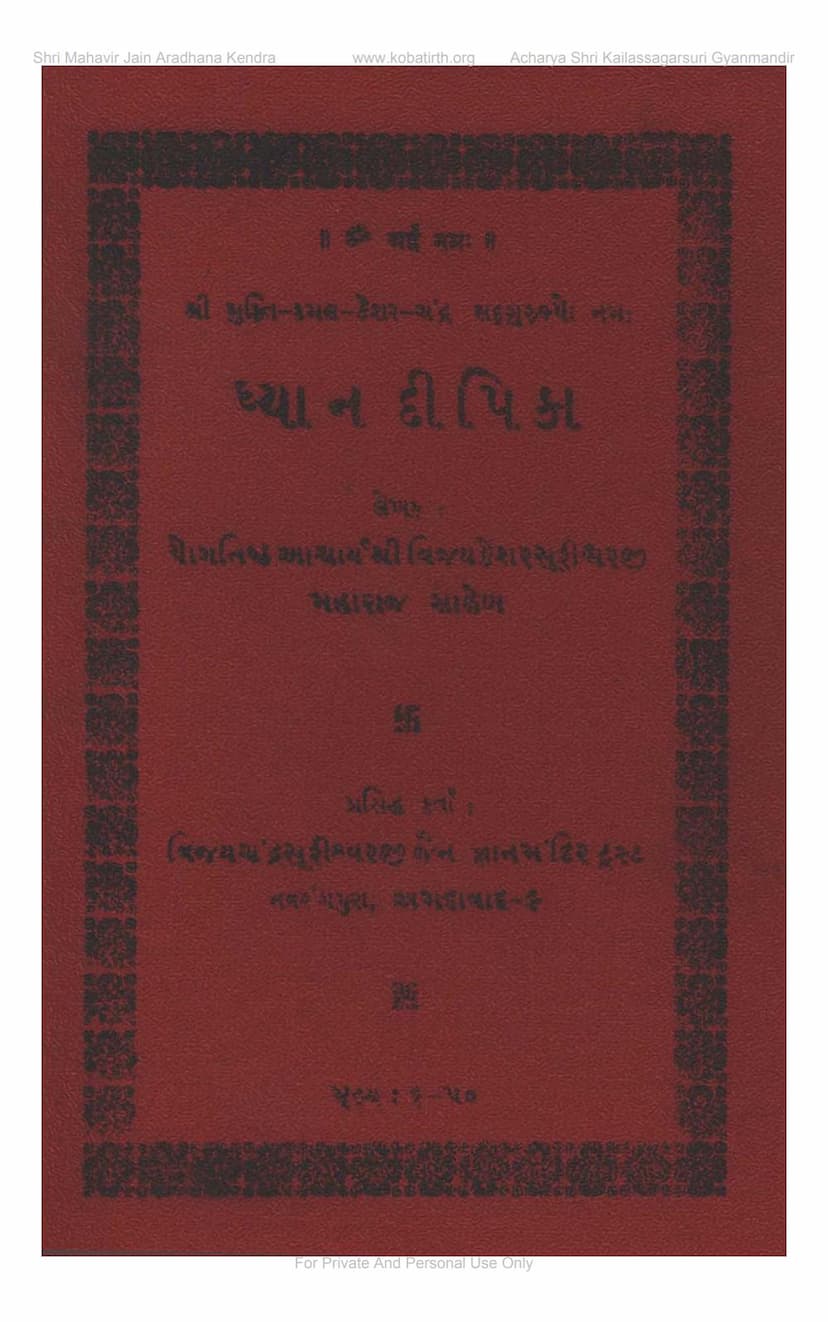Dhyan Dipika
Added to library: September 1, 2025

Summary
Here is a comprehensive summary of the Jain text "Dhyan Deepika" by Kesharsuri, based on the provided pages:
Title: Dhyan Deepika (The Lamp of Meditation) Author: Kesharsuri (as compiled and annotated by Kesarvijay Ganini) Publisher: Vijaychandrasuri Jain Gyanmandir Trust Catalog Link: https://jainqq.org/explore/020315/1
Overview:
"Dhyan Deepika" is a Jain text focused on the practice and philosophy of meditation (Dhyana). The provided content indicates it's a compilation and commentary on earlier works, primarily drawing from the original Sanskrit text by Upadhyay Shakalchandraji. The text, translated and explained by Kesarvijay Ganini and then further commented upon by Acharya Vijay Kesarsurishwarji, aims to guide individuals towards spiritual development and liberation through meditation.
Core Themes and Content:
The book is structured into nine chapters, detailing various aspects of meditation and its importance in the Jain path to liberation. Key themes include:
- The Nature and Purpose of Meditation: Meditation is presented as the core means to achieve liberation (moksha), purify the soul, and realize the true nature of the self. It's emphasized that all worldly pursuits are ultimately futile without spiritual self-attainment.
- The Four Bhavanas (Meditative Contemplations): The text dedicates significant portions to explaining four key bhavanas that are essential for preparing the mind for meditation:
- Jnana Bhavana (Contemplation of Knowledge): Involves studying scriptures, asking clarifying questions, reflecting deeply, and internalizing spiritual truths.
- Darshan Bhavana (Contemplation of Right Faith/Perception): Focuses on developing unwavering faith in the teachings of the Tirthankaras, detachment from worldly pleasures, steadfastness, absence of doubt, and compassion.
- Charitra Bhavana (Contemplation of Right Conduct): Emphasizes restraint in actions, control over mind, speech, and body, adherence to vows, and the endurance of hardships (parishaha).
- Vairagya Bhavana (Contemplation of Dispassion/Detachment): Stresses the transient nature of worldly possessions, relationships, and life itself, urging detachment from sensory pleasures and worldly attachments.
- The Twelve Bhavanas (Anityaadi): Building upon the initial four, the text details twelve contemplations starting with "Anitya" (impermanence), covering concepts like the transient nature of worldly things, the absence of refuge, the cycle of birth and death, solitude, impurity, influx of karma, cessation of karma, and liberation. These are presented as a crucial purification process for the mind before engaging in deeper meditation.
- The Importance of Renunciation and Detachment: The text highlights that true meditation requires renunciation not just of external possessions but also of internal attachments and desires. The lives of ascetics (anagar) are presented as examples of those who embrace detachment to pursue meditation.
- The Four Types of Meditation: The book systematically explains the four types of meditation:
- Arta Dhyana (Painful Meditation): Characterized by thoughts of suffering, loss, or discomfort. It is further divided into four categories: meditation arising from undesirable association, separation from desirable objects, illness, and the pursuit of desires (niyana).
- Raudra Dhyana (Fierce/Harsh Meditation): Driven by negative emotions like anger, pride, deceit, greed, violence, falsehood, theft, and possessiveness. It is also categorized into four types: violence-based, falsehood-based, theft-based, and protection-based.
- Dharma Dhyana (Virtuous Meditation): This is the virtuous and beneficial meditation. It is described as the foundation for spiritual progress and is cultivated through the four bhavanas (Jnana, Darshan, Charitra, Vairagya) and the practice of Yoga's eight limbs (Yama, Niyama, Asana, Pranayama, Pratyahara, Dharana, Dhyana, Samadhi). The text details various aspects of Dharma Dhyana, including the importance of right conduct, control of senses, and the cultivation of positive qualities.
- Shukla Dhyana (Pure Meditation): This is the highest form of meditation, leading to omniscience and liberation. It is described as being free from passions and rooted in pure knowledge. The text mentions its four stages, with the final stages being unattainable by those still bound by karma (chhadmastha).
- The Path to Meditation: The book outlines the necessary qualifications for a meditator, emphasizing the need for knowledge, dispassion, self-control, purity of mind, and unwavering focus. It also discusses the importance of choosing a suitable place and time for meditation.
- The Role of Yoga: The eight limbs of Yoga, including Yama, Niyama, Asana, Pranayama, Pratyahara, Dharana, Dhyana, and Samadhi, are presented as integral to the meditative practice. Pranayama, in particular, is discussed as a means to control breath and stabilize the mind.
- The Ultimate Goal: The ultimate goal of all these practices is to achieve the realization of the soul's true, pure, and blissful nature, leading to liberation from the cycle of birth and death.
Key Concepts Explained:
- Bhavanas: The importance of cultivating specific mental attitudes and contemplations.
- Karma: The role of karma in shaping experiences and the need for its dissolution through meditation and ethical conduct.
- The Four Types of Meditation: Arta, Raudra, Dharma, and Shukla Dhyana are explained in detail, with a strong emphasis on avoiding Arta and Raudra Dhyana and cultivating Dharma and Shukla Dhyana.
- The Eight Limbs of Yoga: Presented as a structured path to achieve meditative states.
- Pindastha, Padmastha, Rupastha, Rupatita Dhyana: Different levels or methods of meditation, from focusing on gross physical forms to the formless.
Author and Context:
The book is attributed to Kesharsuri, but the provided text focuses on the commentary and explanation by Kesarvijay Ganini and Acharya Vijay Kesarsurishwarji. The text's origins are traced back to an earlier Sanskrit work by Upadhyay Shakalchandraji. The compilation and translation process spanned several years, indicating a dedicated effort to make this profound knowledge accessible.
Overall Significance:
"Dhyan Deepika" serves as a spiritual guide, offering a systematic approach to meditation within the Jain tradition. It emphasizes the purification of the mind, the control of passions, and the cultivation of virtues as prerequisites for deep and effective meditation, ultimately leading to spiritual enlightenment and liberation. The text stresses that while external practices are helpful, the internal transformation of the mind is paramount.